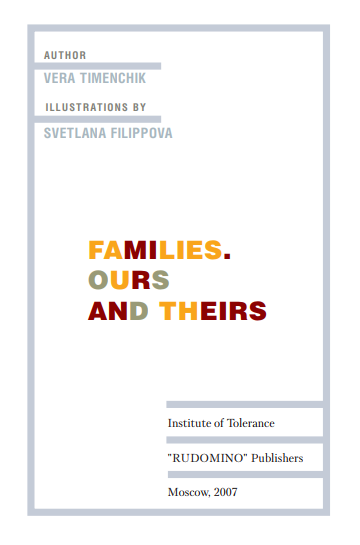New Haven and London: Yale University Press, 2007.
Reviewed by Alexandra Smith, University of Edinburgh
Reviewed by Alexandra Smith, University of Edinburgh
Social Issues in Ludmila Ulitskaia’s Children’s Book Series: Family (2)
 Vera Timenchik’s book, Семья у нас и у других (2006) conveys liberal sensibilities and openly discusses questions that until recently were never raised in Russian schools: xenophobia, school bullying, war in the Caucasus, ethnic intolerance, divorce, homosexual marriage, and marital age. Timenchik centers the book’s plot on two 12-year old friends: Kirill is a native Russian born in Moscow; Daut is a recent immigrant from Abkhazia, an area in the Caucasus. Kirill’s family is small and liberal; Daut’s family is, on the contrary, large and patriarchal. Yet, despite their differences, the Kirill and Daut become friends and learn to accept each other’s differences.
Vera Timenchik’s book, Семья у нас и у других (2006) conveys liberal sensibilities and openly discusses questions that until recently were never raised in Russian schools: xenophobia, school bullying, war in the Caucasus, ethnic intolerance, divorce, homosexual marriage, and marital age. Timenchik centers the book’s plot on two 12-year old friends: Kirill is a native Russian born in Moscow; Daut is a recent immigrant from Abkhazia, an area in the Caucasus. Kirill’s family is small and liberal; Daut’s family is, on the contrary, large and patriarchal. Yet, despite their differences, the Kirill and Daut become friends and learn to accept each other’s differences.
 Don’t miss Galina Iuzefovich’s interview with Liudmila Ulitskaya for Itogi, published today. In the interview, Iuzefovich asks Ulitskaya about her children’s book series project–Другой, другие, о других. Iuzefovich asks, “Если уж говорить о людях не вполне взрослых, то хотелось бы спросить о вашем книжном проекте — цикле познавательных книг для подростков. Почему вы, писатель, а не редактор, не издатель, вообще за него взялись?”
Don’t miss Galina Iuzefovich’s interview with Liudmila Ulitskaya for Itogi, published today. In the interview, Iuzefovich asks Ulitskaya about her children’s book series project–Другой, другие, о других. Iuzefovich asks, “Если уж говорить о людях не вполне взрослых, то хотелось бы спросить о вашем книжном проекте — цикле познавательных книг для подростков. Почему вы, писатель, а не редактор, не издатель, вообще за него взялись?”
Ulitskaya’s answer is very interesting. She says:
If you’re interested in Ulitskaya’s book project, you can read the first four books in the series in English at the UNESCO site.
Welcome to the Working Group for Study of Russian Children’s Literature and Culture blog. My name is Kelly Herold (Grinnell College, Russian Department) and I am the blog administrator.
On this blog, you will find news about Russian children’s literature and culture, links to reviews, and announcements from the Working Group for Study of Russian Children’s Literature and Culture (WGRCLC). We will be posting a few times per week, so check back often or put us in your blog reader.
If you are interested in blogging on Russian Children’s Literature and Culture on a regular basis, we welcome your participation. Posts may be written in Russian or in English. If you are interested in participating, please send me an e-mail.